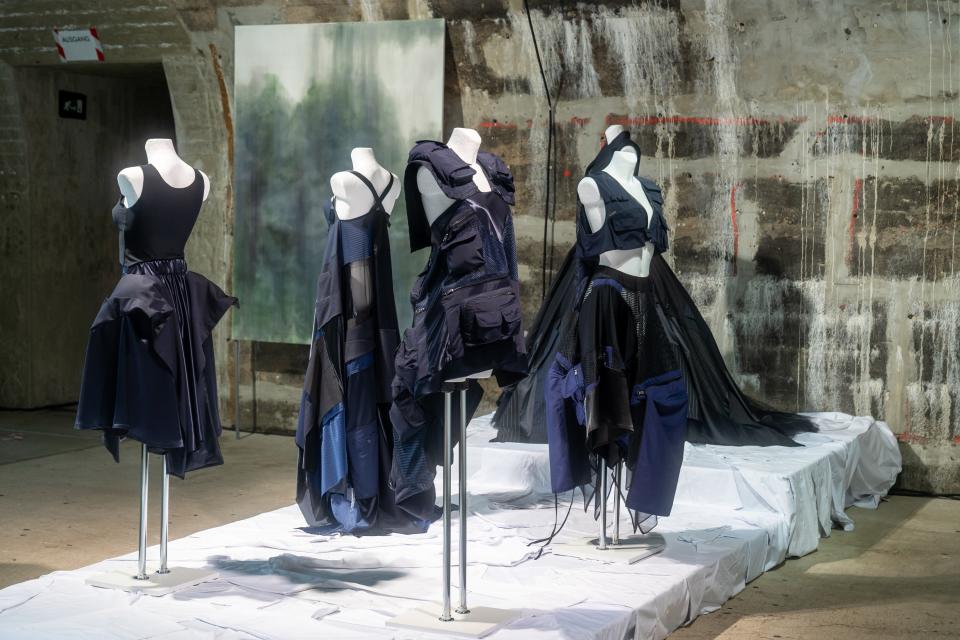Nina Hollein’s Shape-Shifting Fall Collection Is on View in a Frankfurt Museum
- Oops!Something went wrong.Please try again later.
Frankfurt Fashion Week debuted last weekend with a mostly-digital lineup of conferences, live-streams, and video presentations. With ongoing COVID restrictions in Germany, physical fashion shows were few and far between, but there was one IRL event that stood out: “Palindrome,” an exhibition at Kunstverein Familie Montez. Featuring clothes by Nina Hollein and paintings by her brother, Philipp Schweiger, “Palindrome” challenges the viewer to approach both fashion and art as somewhat temporal: Hollein specializes in shape-shifting clothes—a skirt becomes a cape, a dress comes with removable sleeves, etc.—while Schweiger’s abstract landscapes are often installed side-by-side, depicting the same scene from two perspectives.
The museum initially reached out to Hollein about staging a runway show, but given lockdowns and her location—she’s based in New York with her husband, Max Hollein, the CEO of the Metropolitan Museum of Art, and their children—she proposed a collaboration with her brother instead. “We worked out this theme of a palindrome, because it reflects how we both work—my dresses can be worn in different ways, from front to back, as a skirt or a top,” Hollein explains. “The same goes for his paintings. You can read them from either side, and we’re working from two different sides [of the world], geographically.”

Nina Hollein/ Philipp Schweiger - Palindrome (01.07. - 01.08.21)
Photo: Holger Menzel / Courtesy of Nina HolleinHollein’s collection isn’t just transformative in how it’s worn. She also spent most of 2020 retooling how she creates: Everything you see in the Kunstverein was made with upcycled vintage garments—several pieces are comprised of deconstructed men’s suits—while the rest is comprised of leftover fabric from Hollein’s decade-plus in business. Working from home in New York, she hand-stitched every look from start to finish, often with “new” fabric she patchworked together with scraps and extra yardage. A single dress might take Hollein several weeks to complete, though she rarely feels “done.” It’s an intuitive process guided by Hollein’s curiosity and trial and error: “Sometimes I feel like something is finished, and the next day, I have another idea and spend two days making it completely different,” she says. “That’s the beauty of it—you just get on a roll. You’ll make a dress, and it will inspire another dress, or a similar version with different details.”
The exhibition is on view through the end of July, but Hollein isn’t planning to keep the clothes locked up like museum pieces. Several items have already been reserved by private clients, and the rest are up for grabs. “They’re meant to be worn,” she says. “What I really love is when a client finds her own way to wear the clothes. We might do a fitting and everything is perfect, and the next time we meet, I hear she wore it in a completely different style—she combined it with other things, or wore it with a belt… That’s when I feel successful,” she adds. “Because now this customer has made up her mind about what she really likes.”
In a way, that playful relationship between the wearer and the garment is mirrored in the exhibition, where Hollein described “creating a dialogue” between the clothes and paintings. “You might think the paintings are just acting as a background for the clothes, but maybe the mannequins are the viewers,” she points out, adding that both are best appreciated from multiple vantage points, too: close up for the details, or far away for an expansive view. “You aren’t sure what the foreground or background is,” Hollein adds. “In the end, it really works.”
Originally Appeared on Vogue

